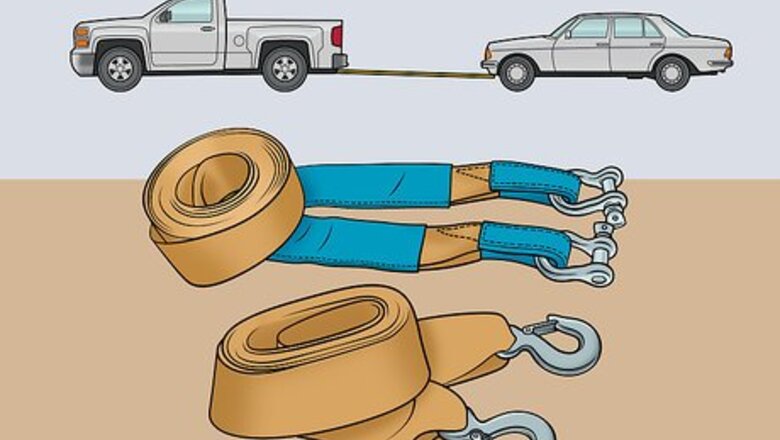
views
Using Tow Straps
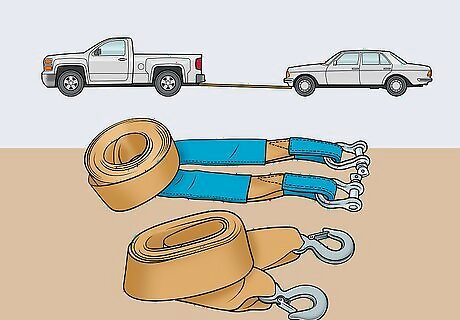
Check local ordinances to ensure using a tow strap is legal. Tow straps are generally considered to be the least safe way to tow a vehicle, and as such, laws may have been passed against the practice where you live. Locate a list of city and state ordinances pertaining to towing and make sure using a tow strap doesn't violate any local laws. There are no nationwide laws banning the use of tow straps. It's recommended that you only use tow straps for short trips or in off-road settings.
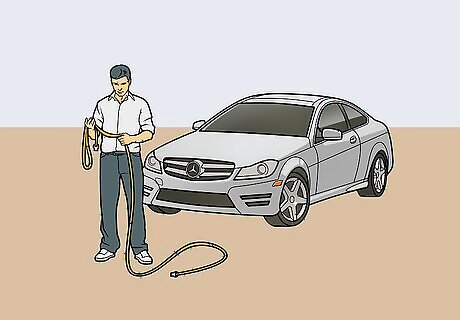
Untangle the tow rope and lay it out in front of the vehicle. Place the end of the tow rope that you'll be connecting to the broken down vehicle in front of it, then work any knots or tangles out of the rope as you lay it down on the ground extended out from the vehicle. This will help you position the tow vehicle properly. Do not use a tow rope with a knot or tangle in it.
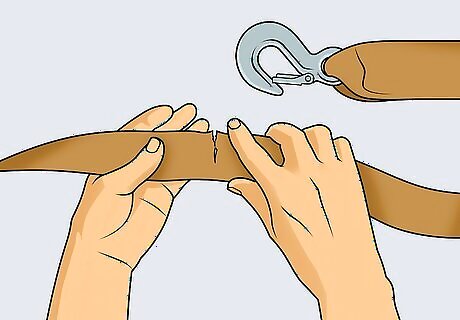
Inspect the tow rope for damage. If your tow rope is torn or frayed, it could break under pressure when you begin pulling the broken down vehicle. Look the entire tow strap over for any sign of damage and don't use the strap if you spot some. This will not only leave you stranded, but it can also be very dangerous. You can purchase a new tow rope at your local auto parts store if the one you have is damaged.
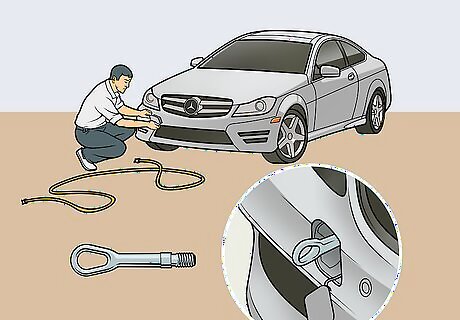
Locate the “recovery point” on the frame of each vehicle. Many vehicles have “recovery points” on the frame, which are often just holes cut into the frame that you can run a recovery strap through or use a steel hook on. Refer to your vehicle's owner's manual to help find the recovery point on the front of the vehicle to be towed, and on the back of the vehicle doing the towing. If you still can't find your vehicle's recovery point, refer to an application specific service or repair manual. Recovery points are always located on the vehicle's frame and are usually circular holes cut through thick steel.
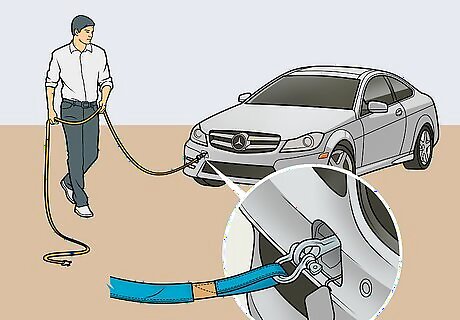
Run the strap or hook through the recovery point on the broken down vehicle. Run the strap through the hole for the recovery point. If it has a hook, use it to hook the strap to itself through the recovery point. If it has a loop at the end, run the strap through the recovery point hole, then run the end of the strap through its own loop to secure it in place. Once you're done, lay the strap flat on the ground extended out in front of the vehicle again.
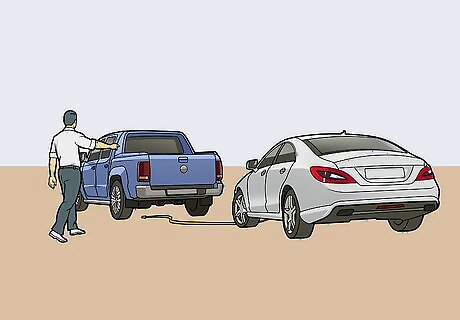
Position the tow vehicle in front of the broken down one. Park it near the end of the tow cable that you laid out in front of the broken down vehicle. Park the tow vehicle so it is lined up with the broken down vehicle so they will both move straight forward when you start towing. Back the vehicle up over the strap by a few feet so there will be some slack to work with. By laying the strap out first, you can position the vehicle so there's isn't a lot of loose slack in the strap.
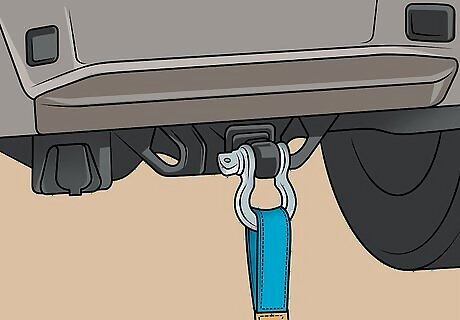
Attach the tow strap to the back of the tow vehicle. If you have trouble accessing the recovery point on the back of the tow vehicle, you can hook the strap to a tow hitch if your vehicle is equipped with one that is at least a Class 2. If you are unsure about your tow hitch, don't use it. Some tow hitches have D-rings you can use to secure the tow strap directly to the tow hitch. Don't hook a metal hook directly to the vehicle if you can help it. Instead, run the strap through the recovery point and hook the strap to itself.
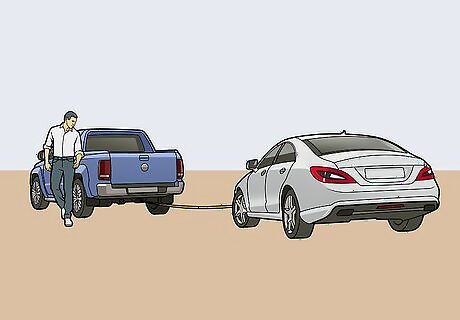
Pull the tow vehicle forward slowly until the strap is tight. Have the driver of the tow vehicle inch it forward slowly until it places enough tension on the tow strap to lift it up off of the ground. Direct the driver to stop once the strap is tight, but before it begins pulling the broken down vehicle. Watch the strap for any signs of fraying or tearing as more tension is applied. Stop immediately if the strap shows signs of damage.
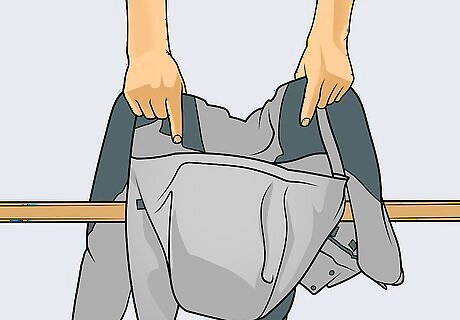
Lay a jacket or blanket on the strap. A broken tow strap can be extremely dangerous. If it snaps, the nylon rope will move like a massive whip and if there are metal hooks involved the danger is compounded. Laying a jacket or blanket over the strap will help to reduce the whip effect if the strap breaks. Stand clear of the strap once the blanket is in place.
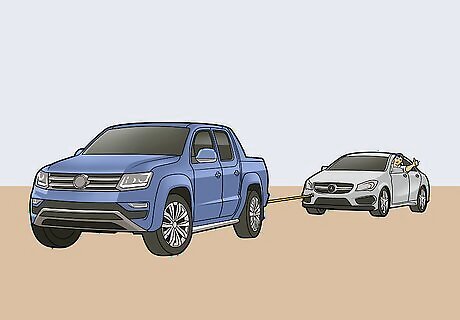
Pull the broken down vehicle very slowly. Ensure the broken down vehicle is in neutral. The strap will pull the vehicle toward the tow vehicle, so the driver of the broken down vehicle will need to control its brakes to prevent a collision while you tow. Only use tow straps to pull a vehicle a short distance, like to get it unstuck. If you have a long distance to cover, you should use either a dolly or a trailer. Disconnect the tow straps when you're done. It is too dangerous to tow a vehicle home using this method.
Towing with a Dolly
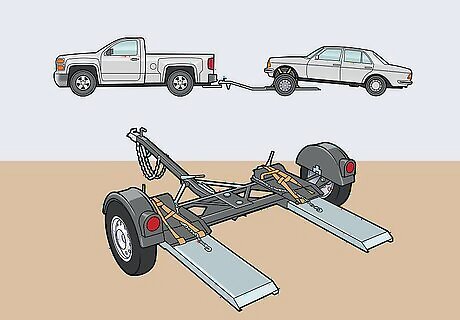
Attach the tow dolly to the hitch of the tow vehicle. Back your tow vehicle up to the tow dolly. It helps to have a friend guide you so you can get the hitch as close to the dolly as possible. Place the ball of the hitch beneath the tongue of the dolly, and then turn the handle that lowers the tongue of the tow dolly to connect the tongue to the hitch. You may need to move the dolly around a little bit to get it to line up properly with the hitch. If your dolly doesn't have a handle to raise and lower the tongue, it's likely light enough for you to lift it up by hand and lower it down onto the ball of the hitch.
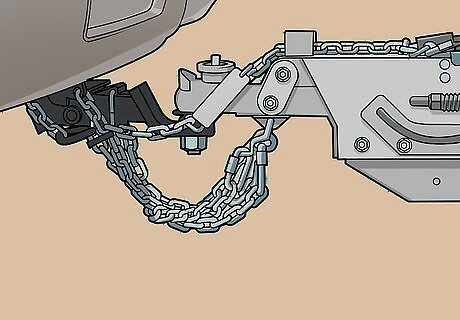
Connect the safety chains and wiring leads. There should be at least two safety chains and one wiring harness coming from the dolly. Cross the chains like an “X” and hang their hooks on the spots for them on either side of the hitch. Then connect the wire harness to the tow vehicle. There will either be an opening for the wiring harness on the hitch bumper, or a wiring pigtail having from the tow hitch that the dolly's wires will plug into. There will be slack in the chains and that's okay. They're only there for emergencies.
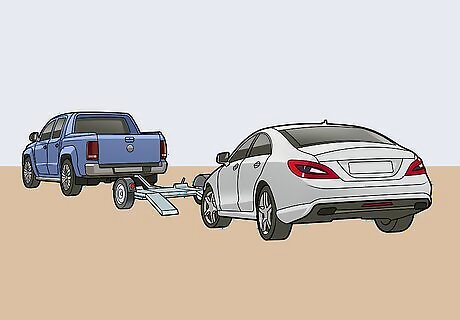
Line up the tow vehicle, dolly, and broken down vehicle on level ground. Back the tow vehicle and dolly up to the nose of the broken down vehicle so it can roll straight forward to put its front wheels on the dolly. If the vehicle you intend to tow runs, you can drive it up to the back of the dolly if that's easier. The tow vehicle, broken down vehicle, and dolly should all be lined up before you try to load the dolly.
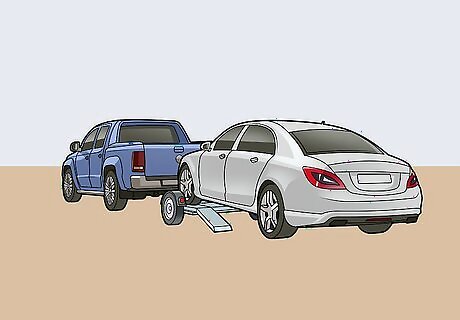
Drive or push the broken down vehicle onto the tow dolly. If the vehicle runs, put it in first gear or drive and accelerate slowly to get the vehicle up onto the dolly. If it doesn't run, ask some friends to push it while you steer and work the brakes. Once the car's front wheels are up on the dolly, use the brake pedal to slow it down so it can't go too far forward. There is a lip at the very front of the tow dolly meant to stop your vehicle from rolling forward any further. Make sure not to accelerate anymore once the wheels are on the dolly, otherwise, the car could go over that lip.
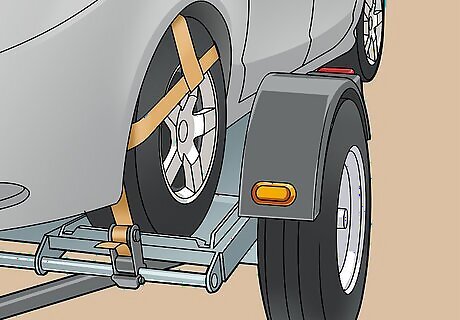
Strap the vehicle to the dolly using the wheel straps. Tow dollies come with wheel straps that go over both front wheels. Pull them over the top of the tires, then use the ratchet mechanism to make them as tight as you can. Then connect the safety chains to the vehicle's frame. With the straps over the tires, open and close the ratchet mechanism to tighten them down. Connect the safety chains to recovery points on the frame you identify through the owner's manual.
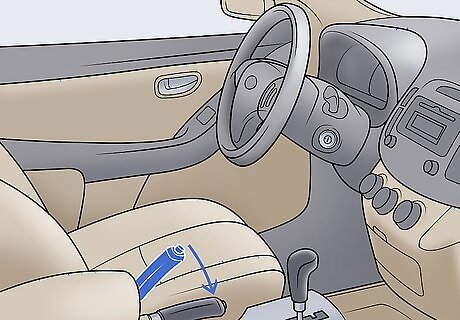
Disengage the parking brake in the broken down vehicle. The rear wheels need to turn freely in order to tow a car using a dolly. Make sure it is not engaged so the wheels can spin freely before setting out. Rear wheels are not connected to the driveline in Front Wheel Drive cars, so there's no need to put the vehicle in neutral.
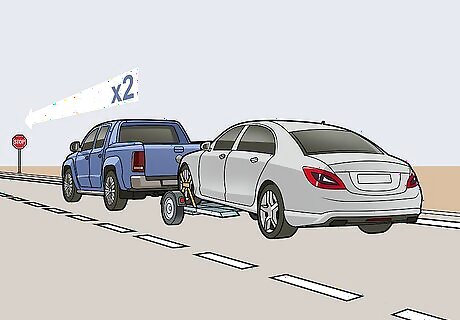
Double your expected braking and acceleration distances while driving. Once you start towing, remember that it will take an average of twice as far to stop, slow down, or accelerate than it normally does in the tow vehicle. Start braking far sooner than you normally would to stop or turn while towing. Do not follow other vehicles closely as it will take you far longer to stop than usual.
Loading a Car on a Trailer
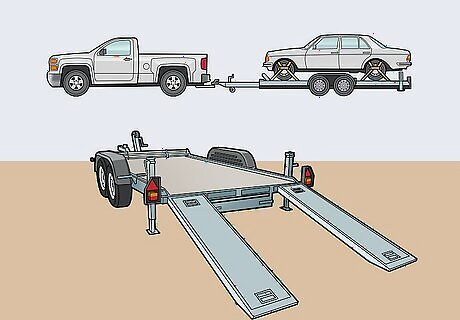
Connect the trailer to the tow vehicle. Back your tow vehicle up to the trailer hitch using your rear view mirrors and some friends to guide you. Once the ball of the hitch is below the tongue of the trailer, rotate the handle on the trailer's tongue to lower it down onto the ball. Once the hitch it attached, cross the safety chains and hang their hooks on the spots for them on either side of the hitch. Connect the electrical plug from the trailer to its port or plug on the tow vehicle.
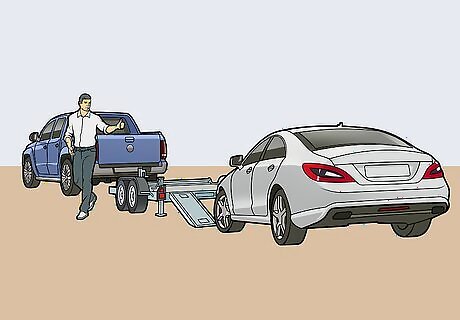
Line up the tow vehicle and trailer directly in front of the towed vehicle. If the towed vehicle is running, it's easier to pull it up behind the trailer, but if it's not, back the trailer up to the front of the vehicle you plan to tow so that it can drive or be pushed straight forward onto it. Ensure the trailer and both vehicles are on a flat, even surface.
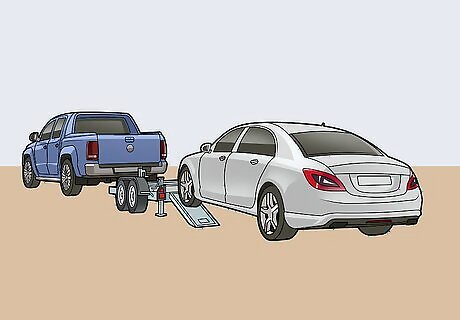
Pull the towed vehicle up onto the trailer. Extend the ramps down on the trailer and then either drive or push the towed vehicle up onto the trailer with someone in the driver's seat to steer and brake. Once the vehicle's rear wheels are on the trailer, tell the driver to stop the vehicle and engage the parking brake. Make sure all four wheels are all the way onto the trailer and that the ramps can slide back in or be folded up without hitting the vehicle. The front tires should be close to the front of the trailer, but don't necessarily have to be touching the front lip.
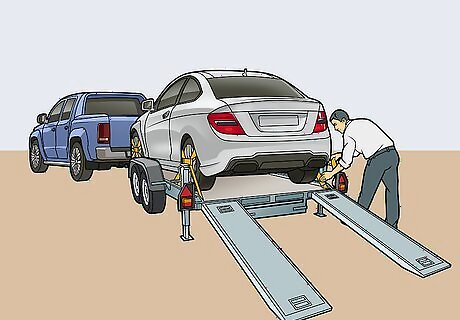
Secure the tire straps and safety chains. Slide ratchet straps over each wheel, then hook them on the trailer and open and close them until they are extremely tight. You should see the vehicle start to ride lower on the trailer as the straps compress the springs in the vehicle's suspension. Then attach the two safety chains to the recovery points on the vehicle's frame. If you are having trouble locating the recovery points to attach the chain to, locate them in the owner's or service manual for the specific vehicle. All four wheels should be strapped down with two additional safety chains on the vehicle when you're done.
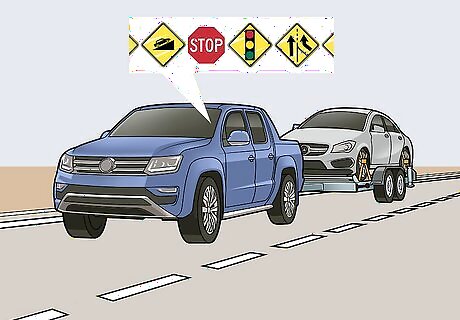
Plan ahead for turns and stops. It takes an average of twice as far to slow down or accelerate when towing a vehicle, so plan ahead when approaching stops, intersections, or turns. Never follow another vehicle closely when towing. Even if your vehicle is powerful enough to accelerate quickly when towing, it may still struggle to effectively brake.




















Comments
0 comment